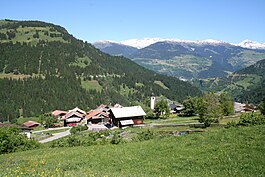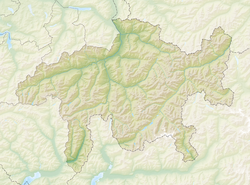Pitasch is a former municipality in the district of Surselva in the canton of Graubünden in Switzerland. On 1 January 2014 the former municipalities of Pitasch, Castrisch, Ilanz, Ladir, Luven, Riein, Ruschein, Schnaus, Sevgein, Duvin, Pigniu, Rueun and Siat merged into the new municipality of Ilanz/Glion.[1]
Pitasch | |
|---|---|
 | |
| Coordinates: 46°43′N 9°13′E / 46.717°N 9.217°E | |
| Country | Switzerland |
| Canton | Graubünden |
| District | Surselva |
| Area | |
• Total | 10.79 km2 (4.17 sq mi) |
| Elevation | 1,060 m (3,480 ft) |
| Population (Dec 2011) | |
• Total | 106 |
| • Density | 9.8/km2 (25/sq mi) |
| Time zone | UTC+01:00 (Central European Time) |
| • Summer (DST) | UTC+02:00 (Central European Summer Time) |
| Postal code(s) | 7111 |
| SFOS number | 3578 |
| ISO 3166 code | CH-GR |
| Surrounded by | Cumbel, Duvin, Riein, Safien, Sevgein |
| Website | www SFSO statistics |
History
editPitasch is first mentioned about 801–50 as Pictaui though this comes from a 16th-century copy of the lost original. In 960 it was mentioned as in Pictaso.[2]
Geography
editBefore the merger, Pitasch had a total area of 10.8 km2 (4.2 sq mi).[3] Of this area, 31.4% is used for agricultural purposes, while 49.1% is forested. Of the rest of the land, 1.5% is settled (buildings or roads) and the remainder (18%) is non-productive (rivers, glaciers or mountains).[3]
The former municipality is located in the Ilanz sub-district of the Surselva district. Before 2000 it was part of the Glenner district. It is located south of Ilanz on a terrace between the Val Renastga and the Val da Pitasch on the old road between Castrisch over the Güner Kreuz to Safien.
Demographics
editPitasch had a population (as of 2011) of 106.[3] As of 2008[update], 2.7% of the population was made up of foreign nationals.[4] Over the last 10 years the population has decreased at a rate of -0.9%. Most of the population (as of 2000[update]) speaks Romansh(60.2%), with the rest speaking German (39.8%).[3]
As of 2000[update], the gender distribution of the population was 52.2% male and 47.8% female.[5] The age distribution, as of 2000[update], in Pitasch is; 19 children or 16.1% of the population are between 0 and 9 years old and 26 teenagers or 22.0% are between 10 and 19. Of the adult population, 8 people or 6.8% of the population are between 20 and 29 years old. 21 people or 17.8% are between 30 and 39, 16 people or 13.6% are between 40 and 49, and 11 people or 9.3% are between 50 and 59. The senior population distribution is 10 people or 8.5% of the population are between 60 and 69 years old, 6 people or 5.1% are between 70 and 79, there is 1 person who is between 80 and 89.[4]
In the 2007 federal election the most popular party was the SVP which received 41.3% of the vote. The next three most popular parties were the FDP (26.5%), the SP (20.9%) and the CVP (11.2%).[3]
In Pitasch about 70.1% of the population (between age 25–64) have completed either non-mandatory upper secondary education or additional higher education (either university or a Fachhochschule).[3]
Pitasch has an unemployment rate of 2.05%. As of 2005[update], there were 20 people employed in the primary economic sector and about 8 businesses involved in this sector. people are employed in the secondary sector and there are businesses in this sector. 6 people are employed in the tertiary sector, with 3 businesses in this sector.[3]
The historical population is given in the following table:[2]
| year | population |
|---|---|
| 1850 | 96 |
| 1900 | 105 |
| 1950 | 125 |
| 2000 | 118 |
Heritage sites of national significance
editThe Swiss Reformed Church building in Pitasch is listed as a Swiss heritage site of national significance.[6]
The Reformed Church was built in the mid-12th century into its current form. The church floorplan is a single nave church with a single half round apse. The interior murals date to about 1420, and on the exterior south wall is a mural of St. Martin and St. Christopher from the studio of the unknown Waltensburg Master which was painted about 1340.[7]
-
Exterior of the Church in Pitasch
-
Interior of the church
-
St. Christopher (Christoforus)
References
edit- ^ Nomenklaturen – Amtliches Gemeindeverzeichnis der Schweiz Archived 2015-11-13 at the Wayback Machine (in German) accessed 13 December 2014
- ^ a b Pitasch in German, French and Italian in the online Historical Dictionary of Switzerland.
- ^ a b c d e f g Swiss Federal Statistical Office accessed 23 January 2014
- ^ a b Graubunden Population Statistics Archived 2009-08-27 at the Wayback Machine (in German) accessed 21 September 2009
- ^ Graubunden in Numbers Archived 2009-09-24 at the Wayback Machine (in German) accessed 21 September 2009
- ^ Swiss inventory of cultural property of national and regional significance Archived 2009-05-01 at the Wayback Machine 21.11.2008 version, (in German) accessed 12-Nov-2009
- ^ Flüeler (1982). Kulturführer Schweiz. Zurich, CH: Ex Libris Verlag AG. p. 281.
External links
edit- Official website (in German and Romansh)
- Pitasch in German, French and Italian in the online Historical Dictionary of Switzerland.



